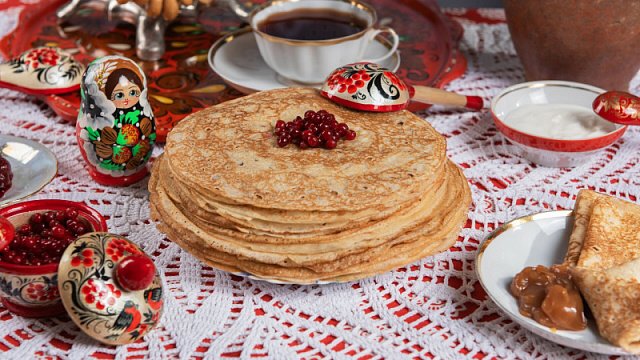11.03.24
16:16
History and traditions of Maslenitsa
Maslenitsa is the oldest folk East Slavic holiday. During the seven days preceding Lent, folk festivals are held in Russia, and families gather for feasts.
The holiday is dedicated to the arrival of spring after a long winter. Maslenitsa has ancient roots and combines Christian and pagan traditions. The dates of the holiday change every year depending on the date of Easter: in 2024 Maslenitsa falls on 11-17 March.
History of Maslenitsa
The first mention of Maslenitsa dates back to the 16th century. It has always been a national holiday that had no age and social restrictions. Maslenitsa week was joyfully met both in the countryside and in the cities.
People started to prepare for the holiday in the middle of the previous week: they put the house in order and prepared food. The Saturday before Maslenitsa week was called “little Maslenitsa”. On this day the deceased were commemorated.
Traditional attributes of the national celebration of Maslenitsa are burning of effigies, folk festivities, sledging, eating pancakes in Russia, dumplings and cheesecakes. On Maslenitsa it is customary to cover abundant tables with plenty of fatty food.
Each day of Maslenitsa has a name and special traditions.
Monday – “Welcoming”. On this day in Russia everyone went to visit each other for pancakes and finished building snow towns.
Tuesday – “Merrymaking”. In the old days, young people of both sexes together skated down hills. On this day it was customary to organise brides’ parties.
Wednesday – “Sweet-Tooth Day”. The son-in-law and his guests go to his mother-in-law for pancakes. Popular outdoor games, such as fist fights.
Thursday – “Wide Maslenitsa”. The first day of Maslenitsa. Everyone stops working and starts celebrating.
Friday – “Mother-in-Law’s Eve”. Mother-in-law and her friends come to her son-in-law’s house for pancakes.
Saturday – “Sister-in-Law’s Gathering”. Wives invite their husbands’ relatives to visit them and, of course, their sisters-in-law.
The most rambunctious day of Maslenitsa is Sunday (Forgiveness Day), when the main festivities are held, and cassockers perform ditties and demand treats.
Maslenitsa is also called a scarecrow made of straw. On the first days of the holiday it is “met”, sledging with it, and on the last day it is burnt on a bonfire.
In Orthodoxy, the last day of Maslenitsa is also called Forgiveness Sunday.
How Maslenitsa is celebrated nowadays
In many Russian cities on Maslenitsa week there are festivals, concerts, various events. In Soviet times, Maslenitsa was not celebrated, but in modern Russia the holiday has become popular again. According to the Russia Public Opinion Research Center (VCIOM), at present, Russians perceive Maslenitsa almost equally as an ordinary holiday (41 percent of respondents) and as an ethno-cultural event (38 percent). According to 4 out of 10 respondents, the primary meaning of Maslenitsa is to welcome spring and spend winter (41 per cent). At the same time, the answers of those who consider Maslenitsa “just a holiday” are equally divided: 46 per cent of respondents see its essence in supporting folk tradition, 45 per cent – to celebrate the change of seasons.
Photo:
IStock
Back

